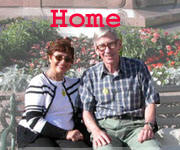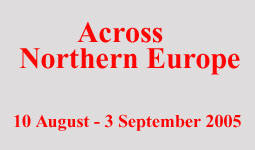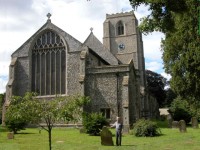Part III - Page 13 14 Go to: Part I Part II Part IV
HINGHAM, ST. JAMES & BECCLES
Sunday, 28 August. We went down for breakfast at 8:30. We could order almost anything we wanted so it was our own fault that we ate too much. As soon as we finished, we left for Hingham, the village my ancestor Joseph Peck moved to in about 1614. Unfortunately, Hingham was too small to be included on the only map we
had of that area of Norfolk. However, I had previously looked at maps that did show it and had a general idea of how to get there.
It turned out to be a bit more complicated than I realized because, after we passed Norwich, there was no turnoff on the motorway until we were well past Hingham. We had to make our way back to it on some very narrow country lanes, arriving at St. Andrew’s Church in Hingham about 10:45, at least half an hour later than we had planned. The church, with walls made of “flint and rubble,” dates from the mid-14th century. By luck, the Sunday service was still in progress, and about 30 people were in attendance. When the service ended (a little after 11:00), we were warmly greeted by the rector and joined several of the parishioners for tea. Robert Peck (1580-1656), the brother of my ancestor Joseph Peck, was twice the rector of this church. In between his terms, he led a group of parishioners to America in 1638. St. Andrew’s is very proud of this connection to America (as well as the 1622 baptism here of Samuel Lincoln, an ancestor of Abraham Lincoln).
After leaving St. Andrew’s, we took pictures of the exterior, including the graveyard that filled two sides of the grounds. Not surprisingly, we found no tombstones dating back anywhere as far as 1638 when my ancestor Rebecca Clark Peck (wife of Joseph Peck) was buried there.
Then we walked and drove around the village. It was so pleasant and quiet, probably not too different than it had been when Joseph Peck lived there. Hingham is literally off the beaten track, a backwater to be frank. But that is what has preserved its character. I had expected Beccles to be like this, too, but you really can’t stop the clock. We walked to Market Square and went into the White Hart Inn and looked around, then walked by some of the larger houses (Beaconsfield House, Admiral’s House, Little London House, Quorn House) before getting the car to roam a little farther.
The shortest route back toward Beccles took us through south Norwich before we could get on the motorway. We drove through the town of Bungay onto some tiny country lanes that took us past several of the original eleven parish churches that comprise the district of South Elmham. Most of these churches date back to Saxon times. “Though anciently of large renown South Elmham, aside from its many ecclesiastical antiquities, is now only what, to American eyes, would appear to be a sweet, beautiful countryside.” - Elias Loomis LL.D. 1875. And he wrote that 130 years ago! Fortunately we had the detailed map I’d borrowed from the proprietors of Saltgate House or we never would have found our way on the narrow country lanes. Several times we met other vehicles, including huge tractors pulling even larger trailers loaded with hay, and we had to pull off the road. The area was completely agricultural and perfectly flat.
It was about 1:30 by the time we finally found our way to St. James South Elmham (or Southelmham St. James), now only a few houses surrounded by large farms. St. James originally was part of a 7th century Deanery founded by St. Felix, and in the 12th and 13th centuries belonged to the Bishop of Norwich. Like South Elmham itself, St. James was once larger and more important than it is today. (There are quite a few references to St. James in genealogy pages found on the Internet.) Church records begin in 1558, 33 years after Robert Peck (the elder) had left.
The Parish Church of St. James is the oldest of the eleven parishes of South Elmham. The north and west walls, as well as the base of the tower, were part of a 12th century Norman church. The baptismal font also dates to that time, and its cover from the 15th century. The holy water font at the entrance is from the 16th century.
There was no one around, but we were surprised and delighted to find the church open. We knew nothing about the church but were fortunate to find a single copy of a welcoming brochure giving a detailed history. We used that as our guide as we explored every aspect of the church.
On leaving St. James, I planned to drive through Halesworth on the way back to Beccles. There
were Pecks living there 1n 1527 who probably were Robert's
relatives, possibly his father and brother. However, we couldn't
find our way on these narrow country lanes even with the map, so
we decided to go back the way we’d come (through Bungay)
We paid more attention to the buildings along Northgate this time. One of the buildings was called “Tannery House” and just beyond it was Tannery Score.” (Each of the several paths from the road to the river was called a “Score.”) This was of particular interest because John Leeke (abt. 1453-1529), maternal grandfather of Robert Peck, had been a tanner in Beccles. However, the Tannery House we saw did not appear to be anywhere near that old.
We walked out on the bridge across the Wavenly river and found a beautiful view up the river to the church in town. I counted boats moored in the river and marina and concluded there were more than a hundred. Jane found a place on the marina to get her afternoon ice cream. We got back to the B&B about 5:30 and rested for a while.
We went out for dinner about 6:30 and thought we’d try the Swan House, a 400 year old former tavern a few steps past the Church Tower. When we walked in, we were completely ignored for at least ten minutes. We finally approached a young woman behind a counter and told her we wanted to eat there. She said we needed a reservation because they were all booked up, even though only one table in the whole place was occupied. We decided to try the India Gate. It was a pleasant little restaurant with excellent service. The food was good, too, but entirely different than what we’d had at the Bombay House the night before. The streets were almost completely deserted as we walked back to Saltgate House. We got there about 8:15 and packed for our morning departure before going to bed.
Part III - Page 13 14 Go to: Part I Part II Part IV |























